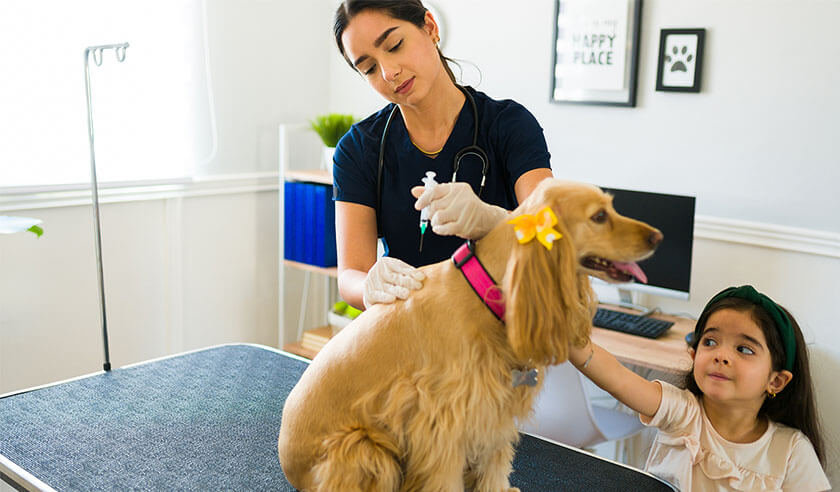There are as many as 900 different species of ticks worldwide, but about 25 are important to pet owners since they can carry diseases that impact our pets.1 These ticks are responsible for transmitting at least 15 different serious diseases to dogs, including Lyme disease, anaplasmosis, and ehrlichiosis.2
Unfortunately, tick exposure is possible year-round in the U.S.3 It just takes one infected tick to spread disease that can be harmful and even deadly to your dog. That's why it's important for you to recognize the signs of some of these diseases. The earlier they're detected, the sooner your dog can receive the treatment they need to make a full recovery.
Most Common Tick-Borne Diseases
Lyme Disease
In endemic areas, up to 50% of ticks can be infected with Lyme disease bacteria, putting many dogs at risk because of their regular exposure to ticks.4 In fact, the prevalence of Lyme disease in dogs ranges from 1.4% to 13.3%.5 Lyme disease has been reported in every state but tends to be more common on the Pacific Coast, in the Northeast, and the upper Midwest.4
An infected deer tick (aka black-legged tick) can transmit the bacteria Borrelia burgdorferi, which causes Lyme disease, when they bite your dog and remain attached for at least 24 to 48 hours. Once infected, dogs develop antibodies against the bacteria, which causes them to test positive for Lyme disease. For dogs who become sick, you may see fever, lethargy, painful or swollen joints with shifting leg lameness, loss of appetite, and enlarged lymph nodes. Lyme disease can cause recurring health problems like arthritis or kidney failure.
Diagnosis of Lyme disease can be difficult. Many clinical signs of Lyme disease are similar to other diseases. A positive test alone does not indicate the disease is present because some dogs can test positive for life, whether or not they show clinical signs.
Ask your veterinarian how to proceed if your dog tests positive but is not showing any signs of Lyme disease. It's recommended that these dogs are periodically seen by a veterinarian and monitored for physical signs to be sure they remain asymptomatic. Talk to your veterinarian about treatment options for your dog.
Anaplasmosis
Anaplasmosis is most common in the Northeast, upper Midwest, and West Coast of the U.S. An infected deer tick or brown dog tick can transmit the bacteria Anaplasma phagocytophilum when they bite your dog and stay attached for 24 to 48 hours.
Physical signs can start as early as one to three weeks after the tick bite, but not all infected dogs will show signs.
The common clinical signs include fever, poor appetite, lethargy, and dehydration. Your dog could also experience vomiting, diarrhea, and painful or swollen joints that cause lameness. Bleeding from the nose, neck pain, and seizures can occur in rare cases.
Ask your veterinarian what to do if your dog tests positive but is not showing clinical signs.
Ehrlichiosis
The bacteria that cause ehrlichiosis can be transmitted within three to six hours of attachment by an infected brown dog tick or lone star tick.
You may start to see physical signs within one to three weeks following a bite from an infected tick. They include fever, lethargy, painful or swollen joints that cause lameness, loss of appetite, weight loss, pale gums, bleeding from the nose or eyes, blood in the urine or poop, decreased platelet count (thrombocytopenia which causes bruising on the gums or belly), and inflammation of the eye (uveitis).
How To Prevent Tick-Borne Diseases in Dogs
Limit Access to Tick-Infected Areas
Ticks prefer shady, humid, and moist environments, usually at ground level (including grassy or wooded areas, leaf piles, overgrown shrubs, and fallen or low-hanging branches). Ticks can also be found in sand or tall seagrass at the beach.
Discourage Ticks from Your Yard
Keep all grass and brush trimmed short. Create a barrier of at least three feet between wooded areas and the yard, patios, porches, and play areas. Gravel or wood chips work well. Keep leaves raked and routinely remove any hanging or fallen branches. Remove any trash or other items that ticks can hide under.
Check Your Dog for Ticks
After your dog spends time outside, thoroughly check their entire body, especially between their toes and around their ears. If you find a tick, remove it right away using these steps.
Vaccinate
Dogs can be vaccinated against Lyme disease, but there is no vaccine for anaplasmosis or ehrlichiosis.
Use Tick Prevention Products Year-Round
Protecting your dog year-round is the best way to help prevent your dog from getting a tick-borne disease. Your veterinarian can prescribe topical, pill, or chewable tick prevention products to help keep your dog tick-free.
With so many kinds of ticks and tick-borne diseases, regular wellness exams and vaccinations are important to your pet’s wellbeing. The earlier a tick or disease is detected, the sooner your dog can get the treatment they need.
ZPC-03843
Important Safety Information: Use with caution in dogs with a history of seizures. Simparica Trio contains sarolaner, a member of the isoxazoline class which has been associated with neurologic adverse reactions including tremors, ataxia, and seizures in dogs with or without a history of neurologic disorders. The safe use of Simparica Trio has not been evaluated in breeding, pregnant, or lactating dogs. The most frequently reported adverse reactions in clinical trials were vomiting and diarrhea. See full Prescribing Information.
SIMPARICA TRIO is indicated for the prevention of heartworm disease caused by Dirofilaria immitis and for the treatment and control of roundworm (immature adult and adult Toxocara canis and adult Toxascaris leonina) and hookworm (L4, immature adult, and adult Ancylostoma caninum and adult Uncinaria stenocephala) infections. SIMPARICA TRIO kills adult fleas (Ctenocephalides felis) and is indicated for the treatment and prevention of flea infestations, and the treatment and control of tick infestations with Amblyomma americanum (lone star tick), Amblyomma maculatum (Gulf Coast tick), Dermacentor variabilis (American dog tick), Ixodes scapularis (black-legged tick), Rhipicephalus sanguineus (brown dog tick), and Haemaphysalis longicornis (Asian longhorned tick) for one month in dogs and puppies 8 weeks of age and older, and weighing 2.8 pounds or greater. SIMPARICA TRIO is indicated for the prevention of Borrelia burgdorferi infections as a direct result of killing Ixodes scapularis vector ticks.
1. Range Expansion of Tick Disease Vectors in North America: Implications for Spread of Tick-Borne Disease. National Library of Medicine. https://www.ncbi.nlm.nih.gov/pmc/articles/PMC5877023/. Accessed February 18, 2025.
2. Ticks. Companion Animal Parasite Council. April 12, 2017. https://capcvet.org/guidelines/ticks. Accessed February 18, 2025. (citation provided by Zoetis via article brief)
3. Ticks. CDC. https://www.cdc.gov/ticks/prevention/index.html Accessed February 18, 2025.
4. Lyme Disease (Lyme Borreliosis) in Dogs. Merck Manual. Veterinary Manual. https://www.merckvetmanual.com/dog-owners/disorders-affecting-multiple-body-systems-of-dogs/lyme-disease-lyme-borreliosis-in-dogs. Accessed February 18, 2025.
5. Lyme Disease. Companion Animal Parasite Council. https://capcvet.org/guidelines/lyme-disease/. Accessed February 18, 2025.






